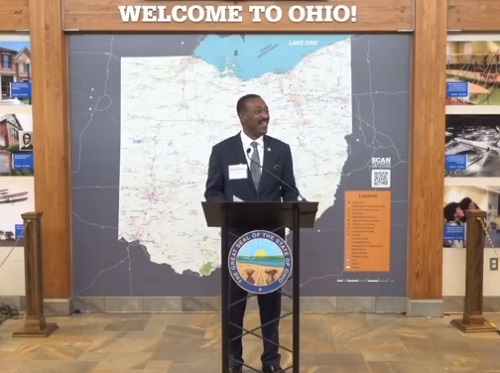Governor Mike DeWine (R), the Ohio Department of Transportation, and the Ohio Department of Development recently unveiled a plan to replace and upgrade rest area buildings situated along state highways over the next four years.
[Above photo by Ohio DOT]
“Our rest stops give travelers, truck drivers, and families a safe place to rest, which can increase focus and safety when they get back on the road,” Gov. DeWine noted in a statement. “While they’re stretching their legs, we want to share Ohio’s amazing story, and tell them about our innovative Ohioans, beautiful natural resources, and exciting attractions.”
The plans calls for the construction of 33 new rest areas throughout the state by the end of 2026, with dozens of other Ohio rest area facilities getting upgrades, which includes providing them with native landscaping and displaying regional tourism information within their structures.
The governor showed off an example of what the state’s new rest area buildings would look like during a press event held at the Preble County Welcome Center, just inside Ohio’s western border.
While the new building at the Preble County Welcome Center opened in 2019, the site underwent a “re-imagining” with upgrades that include the addition of native Ohio plants, extensive landscaping, the addition of dog trails, rocking chairs, and a “Storybook Trail” for travelers along the building’s exterior.
Inside the facility, visitors can learn about Ohio’s history as the “Birthplace of Aviation” and see places of interest to help plan their next adventure to the area. Guests can scan QR codes on the walls for more information about other nearby attractions, such as the historic Paul Laurence Dunbar House, local and state parks, Ohio public universities, and other historical sites. A 10-foot map of Ohio highlights popular attractions.
Those enhancements resulted from a collaboration between the Ohio DOT and the Ohio Department of Development, noted Ohio DOT Director Jack Marchbanks.
“For decades, Ohio’s rest areas have been a place for travelers to stop and recharge,” he said. “We are excited by the governor’s vision to leverage these locations to help teach travelers about all the wonderful experiences Ohio has to offer.”
Other states are also engaged in similar rest area upgrade efforts.
For example, in March, the Arizona Department of Transportation released a draft statewide rest area study that will serve as a blueprint for how the agency plans to address both short-term and long-term priorities for rest areas due to increasing commerce, tourism and population.
That study outlines how the agency expects to preserve, rehabilitate, modernize and expand its 19 state-owned rest areas during the next 20 years based on factors including demand, federal requirements and projected available funding. The Arizona DOT noted its statewide rest area plans get updated every 10 years to capture the latest changes in the rapidly growing needs of the traveling public, the transportation industry, state and federal policies, technology and potential revenue. Since the last update in 2011, the agency said it has completed major rehabilitations at 16 of its 19 rest areas.
 States
States
NCDOT Staff Participate in ‘Explosive’ Technical Training
December 19, 2025 States
States

